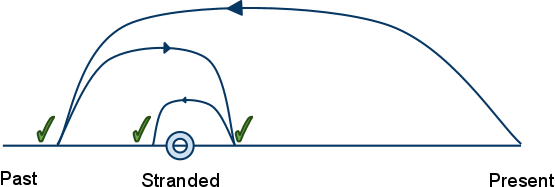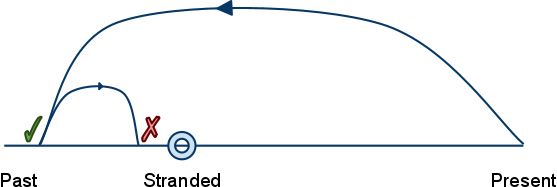
by Don Kirkby
Guide your rescuers to find you in time.
Number of players: 2 or more
Equipment: 3 dice, paper and pen for keeping score
Your time machine broke down, and your team is coming to rescue you in a time-travelling tow truck. In this game, you and your teammates take turns as stranded time agents guiding the rest of the team to rescue them from the past. After five rescues, whichever team spent the least time trapped in the past wins the game.
Luckily, your time machine is not completely broken - it can still drift forward toward the present. During recent history, it takes a month to drift one year forward. The farther back in the past you are, the faster you drift forward. The big table at the end of these rules shows how many months it would take to drift forward from any year to the year 2001, when your time machine was built in a secret lab. Your time machine can travel as far back as 2000 BCE, and it would take you 18 years to drift back to the present from there. Hopefully, you can guide your rescuers closer to you in time, so you won’t have to wait that long.
As you know, time travel is tricky. One wrong move, and the world is ruled by mutant ants! In order to avoid such mishaps, you must communicate with your rescuers using strict protocols. All time agents bring an entangled quantum communicator with them from the present that can send one message to the rescuers. Unfortunately, just telling the rescuers what year you are in would cause a catastrophic paradox. However, you can describe current events so the rescuers can work out when you are stranded.
If the rescuers jump, but they miss you by a few years, you may be able to send them another message. It depends on whether they hopped over your position on the timeline and re-entangled the quantum communicators. Every time they hop over your position, you can send another message describing a current event to try and bring them closer to you. In fact, if they are jumping from far in your future, you can describe an event from a few years in your past just to make sure they pass over you. If they are jumping from far in your past, you can describe an event from a few years in your future. There’s no limit to the number of hops, but it takes one month to recharge the tow truck for each jump.

In the diagram above, the rescuers made three jumps, and each time they passed over the stranded agent so they could continue to communicate. In the diagram below, the rescuers’ second jump did not pass over the stranded agent, so they cannot communicate and must spend a few months trapped in the past until they drift forward to the agent’s time.

When the rescuers stop jumping, whichever group is earlier drifts forward through time until they reach the others. See the table to calculate how many months it takes to drift. Find the two years in the table, and subtract the two drift times to get the drift time between them. If a year you need isn’t in the table, use the next year that is in the table. For example, if the rescuers stop in 1400, the next year that appears in the table is 1407. If you’re stuck in 1452, then it takes two months for them to drift to you.
With four or more players, divide into two teams with at least two players on each team. Teams can have different numbers of players. On each turn, one team will choose an agent to be rescued from the past. When both teams have performed five rescues, the team with the lowest total score wins. In case of a tie, the team with the lowest score for a single rescue wins.
With three players, each player rescues each of the other players once. Keep track of each player’s score separately and add the time for each rescue to the score for the two participating players. The player with the lowest total score after all six rescues wins.
With two players, take turns rescuing each other. After each player has been rescued five times, add up the total score for all ten rescues. 50 or less is an expert score, 100 or less is good, and more than 100 means you need to review some world history.
On each turn, choose a player to be the agent. The agent rolls the three dice and reads the three numbers from left to right, then finds those numbers in the roll column of the drift table at the end of these rules. The agent is now stranded in the year next to that roll, so they write down the year on the score sheet, show it to the other team, and then hide it. The rescuers should look away while the agent rolls the dice and finds the target year.
Now the agent describes an event from some time near the target year, the rescuers discuss when they think it happened, and then they tell the agent what year they’re jumping to. This repeats as long as they keep passing over the agent and the agent wants to keep them jumping.
Alice is the time agent and rolls 4-5-6 on the dice. She looks in the table and finds roll 456 is in the year 1811. As much as she would like to say, “The war of 1812,” she knows that saying a year would cause a paradox. She says, “The American declaration of independence is signed.” Bob and Charles are the rescuers and they say 1776 after discussing it. Since they passed over Alice, she can give another clue and says, “Jane Austen publishes Emma.” They don’t really know when it was published (1816, in case you’re curious), but they guess 1850. Now Alice says, “Napoleon is banished to Elba.” Again, they’re not really sure, but they guess 1800. At that point, Alice decides to stop the jumping. She looks in the table to see that it’s a two-month drift between 1800 and 1811. The team spent three months jumping and two months drifting, so they add five to their score.
|
|||||||||||||||||||||||||||||||||||||||||||||||||||||||||||||||||||||||||||||||||||||||||||||||||||||||||||||||||||||||||||||||||||||||||||||||||||||||||||||||||||||||||||||||||||||||||||||||||||||||||||||||||||||||||||||||||||||||||||||||||||||||||||||||||||||||||||||||||
|
|||||||||||||||||||||||||||||||||||||||||||||||||||||||||||||||||||||||||||||||||||||||||||||||||||||||||||||||||||||||||||||||||||||||||||||||||||||||||||||||||||||||||||||||||||||||||||||||||||||||||||||||||||||||||||||||||||||||||||||||||||||||||||||||||||||||||||||||||
|
|||||||||||||||||||||||||||||||||||||||||||||||||||||||||||||||||||||||||||||||||||||||||||||||||||||||||||||||||||||||||||||||||||||||||||||||||||||||||||||||||||||||||||||||||||||||||||||||||||||||||||||||||||||||||||||||||||||||||||||||||||||||||||||||||||||||||||||||||